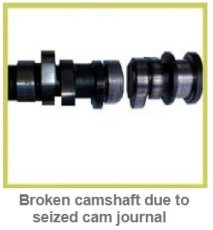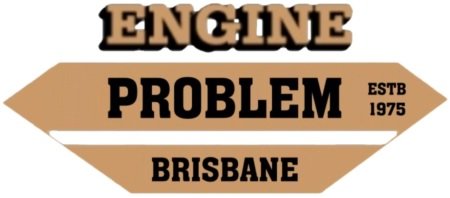Camshaft Engine Problem

Camshaft engine problem - CRACKED / BROKEN
When a camshaft breaks it is generally the result of another component failure. In the case of pushrod engines contact with a broken con rod is the usual cause. This is only resultant damage and has no bearing on the condition of the camshaft. Some pushrod OHV engines such as Holden202 blue and 6 cylinder Ford Falcon engines have camshafts designed with cut outs in the camshaft to accommodate the conrod when it travels past. If the cam timing is lost during high revs (broken chain or gears) the con rods will contact the camshaft causing the cam to be broken. Other serious damage can occur at the same time causing the block to be unserviceable.
OHC engines break camshafts usually after a seizure of a cam journal in the head. The camshaft breaks between the seized journal and the cam driven gear or cog. Most belt driven OHC engines strip the cam belt before breaking the camshaft. Chain driven OHC engines are more prone to break a cam under these circumstances as the chain drive is more robust. When this occurs all camshaft chains or belts must be replaced even if they appear to be ok. All timing chain components should be replaced as the force required to break a seized camshaft has exceeded what the timing components were designed to handle.(adjusters, rails, idler bearings, thrust plates, chains, gears and sprockets)
: Every care has been taken in writing this information and procedures, but no responsibility can be excepted for errors, omissions or misuse of this information and procedures. The information available on this site is for your instruction only and cannot be copied for sale, © copyright 2020 UMR Engines www.engineproblem.com.au

Camshaft engine problem - PICKED UP / SEIZED
Camshafts in older design engines such as side valve or pushrod engines are less prone to camshaft seizure or pick-up. This only appears to happen when cam bearings are fitted incorrectly. A common cause is the oil feed holes are misaligned upon cam bearing fitment.The other faulty workmanship problem exists when the bearings are fitted with not enough clearance. Camshaft must turn freely with no tight spots. Newly fitted bearings should be inspected for witness marks after a dummy fit and spin of the camshaft. Care has to be taken not to damage the bearings when fitting and removing the camshaft. Camshaft bearing journals must be measured to ensure correct size cam-bearings are used. (Also check the tunnel size and journal size as some engines have oversize backed bearings to accommodate for tunnel boring and journal grinding.) Some later model v6 pushrod engines suffer from cam seizure due to suggested miss-alignment of cam tunnel during manufacture. Oversize-backed bearings have been produced to rectify this problem.
OHC ENGINES, especially those designed with alloy cylinder heads suffer more commonly from camshaft pick up or seizure. The oil feed by the nature of the design is the furthermost point from the oil pump. The oil feed hole is generally small or has a restrictor so as to control the amount of oil supplied to the over head gear. This hole is adequate when the engine is new and internally clean. As the engine sludges up the oil feed hole often becomes blocked causing oil starvation with in turn results in camshaft seizure. The breakdown in lubrication causes the alloy head cam tunnels or bearings to weld themselves to the camshaft resulting in total cam seizure. Quite often these engines suffer sever resultant damage such as bent or broken valves, piston damage, rocker arm and valve guide breakage.
Some manufacturers have designed what is called a safe engine where the crankshaft and pistons can turn independently to the camshaft without contact with stationary open valves. The main causes of camshaft pick-up or seizure are lack of lubrication or severe overheating.
Another common cause is the practice of surface grinding a bent OHC head without firstly physically straightening the cylinder head. The camshaft tunnels must be aligned before the head is surface ground. Several methods are used by engine reconditioners to straighten alloy heads. The head should also have a hardness test to ensure the serviceability of the head.
Some alloy heads require straightening and also tunnel boring to correct the alignment. Incorrectly fitted slipper type bearing shells is a less common cause in OHC seizure but some designs allow this to take place. Most engine designers have different offset tangs on the slipper type bearings to stop the fitment of upper and lower halve shells incorrectly. When fitted incorrectly the oil feed to the camshaft is blocked causing the cam to seize in a short period.
: Every care has been taken in writing this information and procedures, but no responsibility can be excepted for errors, omissions or misuse of this information and procedures. The information available on this site is for your instruction only and cannot be copied for sale, © copyright 2020 UMR Engines www.engineproblem.com.au

Camshaft engine problem - FLOGGED / WORN OUT
Camshaft lobes are very prone to wearing out or being wiped as it is referred to. The downward force created by the valve spring combined with the wiping action of the lobe creates a critical point of stress at the lifter that can develop into lobe failure. The lubrication of this point is very important, as the hardened lifter will quickly destroy the lobe if there is surface contact between the lifter and lobe. Modifications to valve springs, valves or lobe profile can promote lobe failure. If a failure of a lobe occurs soon after a camshaft grind it is important to check the finish and convex profile of the lifter base. (.001" to 002")
The first few seconds of a reground camshaft's life is very critical. A dry start will start the scuffing of the lobe and total failure as the lobe is wiped away. A small amount of cam lube on new reground lobes is a good practice to help initial bed-in of cam lobes to lifter. (Caution as to the amount of anti-friction additives are used as piston ring bed-in can be effected.)
As described elsewhere in this section oil pressure must be established under cranking speed if a new engine is to have a chance to survive.
: Every care has been taken in writing this information and procedures, but no responsibility can be excepted for errors, omissions or misuse of this information and procedures. The information available on this site is for your instruction only and cannot be copied for sale, © copyright 2020 UMR Engines www.engineproblem.com.au
